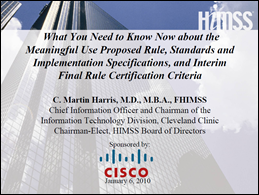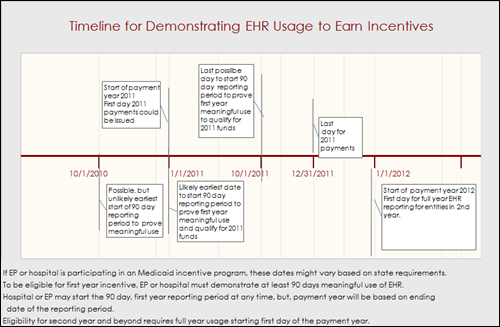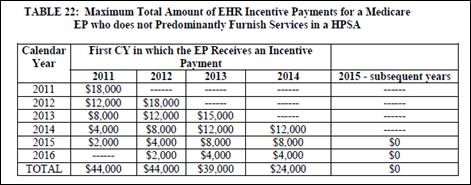News 1/7/09
AdvancedMD, a practice management software vendor, acquires PracticeOne, the company behind the e-Medsys software. AdvancedMD needed am EMR solution and PracticeOne is already 2008 CCHIT-certified. Interestingly,the smaller PracticeOne also offers a practice management system, so likely one of the PMs will disappear.
I sat in on a HIMSS webinar today that provided more clarification on the latest proposed meaningful use and certification criteria. The slide presentation can be downloaded here. If you don’t want to go thought the full 700 page of the original documents, the 57 slides provide a pretty good summary. I thought the best part of the session was the audience Q&A and took note of some of the better questions, along with the answers from HIMSS staff members:
Q: What if a group of doctors pools their money together to purchase their EHR, then one of the doctors leaves. What happens to their $44k?
A: The determination of an EP and incentive payments is not based on ownership or purchase of the EHR.
Q: We bill our employed Medicare claims as hospital-outpatient (place of service code 22). Is it true that this rules them out from being eligible for incentives?
A: Yes.
Q: What are the dates of the first reporting period?
A: For EPs it’s January 1, 2011 – December 31, 2011. For hospitals, it’s October 1, 2010 – September 30, 2011. (Note from Inga: though the certification criteria does say October 1 to September 30 for hospital payments, my interpretation is that the committee is recommending that the start of the first reporting period be pushed to January 2011. The reasoning is that vendors and hospitals would have more time to prepare.)
Q: Am I correct that an EP cannot begin reporting until 2012 and not lose incentives?
A: You are correct. And 2013 for hospitals.
Q: So what is the incentive for a provider to start in 2011 instead of waiting until 2012?
A: Payment will be sooner.
Q: To count as CPOE, must the provider personally (hands on keyboard) enter the order, or may physical entry of the order, under the provider’s direction, be done by other staff?
A: The reg states “directly”
Q: Do nurse practitioners qualify as EPs? What about physician assistants?
A: Nurse practitioners only under the Medicaid incentive program. PAs only under Medicaid in some circumstances.
If you have any questions about the latest proposed guidelines, feel free to drop us a note. Mr. H and I pledge to track down answers from our wealth of experts.
KLAS reports that 85% of healthcare providers believe their ambulatory EMR software will enable them to meet the 2011 meaningful use deadlines. Epic, NextGen, and athenahealth customers expressed the most confidence; SRSsoft and Amazing Charts clients expressed the least. KLAS says that of all the products reviewed, only Allscripts Enterprise had 100% of interviewed clients able to digitally transmit qualifying orders.
Speaking of Allscripts, Mountain States Health Alliance (TN) selects Allscripts EHR/PM solutions for its 300 employed and affiliated physicians.
CMS says that healthcare spending rose at a record low 4.4% rate in 2008 due to the recession, but still reached $2.3 trillion. That spend represents over 16% of the US economy.
MeritCare Health System (ND) says they are looking to add a new EMR and expect to spend $10 to $15 million over the next five years. The organization includes over 400 providers across 42 locations.
Ten-provider Orthopaedic Center of Southern Illinois chooses the SRSsoft EMR after its free trial, saying the docs are saving 30-60 minutes each per day.
eClinicalWorks partners with Krames to offer patient education tools for practices using eClinicalWorks 8.0 software. The patient education will tie to patients’ individual medical records and also be available via the eCW Patient Portal.
Aprima adds HIT Systems as its latest reseller.
The 42 physicians at Asheville Radiology Associates select AMICAS Financials for radiology billing, AMICAS Dashboards for BI, and AMICAS Patient and Payer Services.
George Washington University Medical Faculty Associates (DC) pick RealMed for electronic claims processing and adjudication.
Trinity Health (MI) buys 1,200 bundled EHR/EPM software licenses from NextGen, increasing its rollout to all employed providers in its network.
A man walking to the grocery store finds a bunch of patient medical records scattered on the street. Rather than call the home health agency whose name was stamped all over the paperwork, or even the police, he calls the local news station. The TV station collects the paperwork and pays a visit to the agency. The manager admits a staff member accidentally lost a bag with the charts and wasn’t able to get all the paperwork back. Rather than give the agency the papers back, the TV station contacts the state attorney general. I’m all for patient privacy, but why does it seem everyone wants to get a moment in the spotlight rather than just do the right thing?














The article about Pediatric Associates in CA has a nugget with a potentially outsized impact: the implication that VFC vaccines…